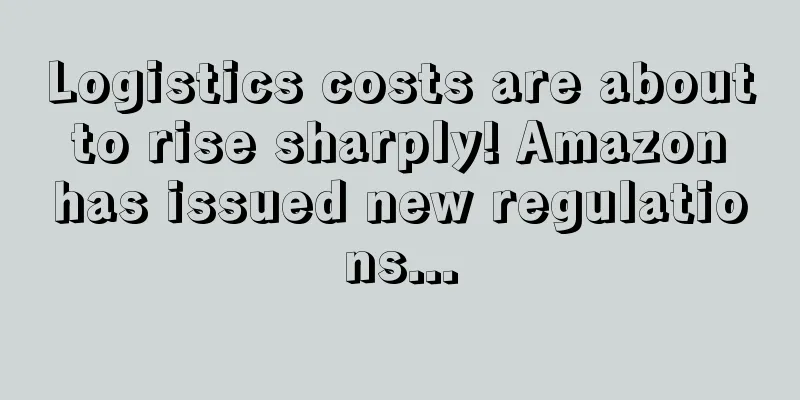Peak season warning! Multiple Amazon warehouses continue to be overstocked

|
The problem of margin calls broke out completely.
Amazon's autumn promotion has ended, but the warehouse overflow situation has not eased, but has intensified, and even new warehouse overflows have become normalized. The strike in the eastern United States and the upcoming Member Day promotion have exacerbated the current situation of warehouse overflows, and cases of rejection and contract adjustment have occurred on a large scale, and there have even been reports of a new round of price increases by shipping companies.
Amazon's warehouses continue to be overwhelmed
As the peak season arrives, Amazon sellers are frequently faced with challenges in logistics.
The autumn promotion did not meet expectations, and transfer warehouse out-of-stock errors have become the complaints of sellers recently. Among the sellers, the word "warehouse explosion" is also on the list. Among them, the problems with Amazon's newly established warehouses in the United States this year are the most frequent.
According to feedback from industry insiders, the two new warehouses ABQ2 and PSC2, which had a large warehouse explosion in September, are still experiencing serious warehouse explosions recently, and there are risks of not releasing contracts, continuously canceling contracts, postponing contracts, and even refusing to accept them. Even if they are signed for, they are transferred to other warehouses. Other new warehouses QYX5 and JOT1 are in a state of continuous non-releasing of contracts.
In addition, the situation of some popular warehouses in the United States is not optimistic. Take the West Coast as an example, there are large-scale warehouses that are out of stock. Specifically, SBD1 is out of stock, and the contract approval time is four weeks later ; although the situation of LGB8 has eased, the contract approval time is still two weeks later, and cases of rejection and contract skipping still occur frequently. ONT8 has not been able to get a contract until early November.
“Either already full or on the way to full” is the best way to describe warehouses in the western United States. It is understood that warehouses including MCE1, XLX7, GYR2, etc. have also experienced a certain degree of fullness, and the approval time is often a week or even longer, and the possibility of delivery delays is very high.
The warehouse explosion situation in the US and China has been relatively alleviated. The explosion of FWA4 and MDW2 has been alleviated, and the release time is two weeks later. The approval and release time of popular warehouses such as FTW1, IND9, and DEN2 is basically about one week. The average unloading time is long, ranging from 15 to 48 hours.
Compared with the West Coast and Central Coast, the East Coast is relatively optimistic. The CLT2 warehouse explosion has eased, with the release time being two weeks later, and there have been cases of unloading exceeding 10 hours. The explosion of a few warehouses has intensified, with warehouses such as ABE8 taking three weeks to approve contracts ; TPA2 and AVP1 take about one week to approve contracts.
In fact, it is not difficult to see from the above-mentioned situations that Amazon’s warehouses in many locations are once again caught up in problems such as contract cancellation and contract skipping. The situation is serious and it will take some time to resume normal operations.
On the one hand, the warehouse had just received the autumn promotion goods and started to receive the goods for Black Friday and Cyber Monday, so the warehouse had no chance to "catch its breath" and faced challenges in carrying. On the other hand, new warehouses had frequent problems. Amazon's original intention was to open new warehouses to solve the problems, but it never expected that the warehouses were not only expensive and remote, but also not well received by sellers.
Many sellers complained that the inventory allocation fee was also charged, the shipping cost increased, and the time to put the products on the shelves became slower and slower. In addition, the impact of the strike at the Port of New York in the eastern United States is still continuing. According to foreign media reports, the Port of New York is still congested and it will take about 20 days to recover.
In fact, the warehouse situation in the United States is not optimistic only, but also in Europe and Canada.
"DPD warehouse at the end of the European line is seriously overwhelmed and warehouse P2 is closed," a seller reported. According to the freight forwarder, Amazon Europe warehouse is overwhelmed and goods cannot be delivered. All goods can only be piled up in the warehouse. For this reason, DPD decided to close the warehouse and cannot deliver goods until October 16th local time.
In addition, BHX4, LBA4, and WRO5 also experienced serious warehouse overflows, among which LBA4 goods need to wait at least two weeks before entering Amazon.
Warehouses in many places are overwhelmed, and a new round of price increases is coming
In Canada, affected by the workers' suspension of overtime and other factors, many warehouses have also experienced warehouse overflows. Among them, YYZ4, YOO1 , YOW1 , and YOW3 warehouses are seriously overwhelmed, and YYC6 and YEG2 are difficult to book . Recently, Montreal dock workers have once again stopped overtime indefinitely, which may aggravate the local warehouse overflow situation.
Warehouse overflows have made countless sellers anxious about the big sale, and changes in the shipping market are also affecting sellers’ costs.
Freight forwarders in the industry revealed that the current US shipping market is experiencing a serious situation of container abandonment. For example, COSCO South China experienced serious container abandonment at the end of September, and the situation worsened in the first week of October. At the same time, container abandonment by ZIM and Evergreen is also intensifying. At the same time, shipping companies including Maersk and Hapag-Lloyd have once again announced a new round of freight rate adjustment plans involving routes such as the Mediterranean and South America.
It is understood that Maersk will increase the FAK rates from the Far East to Northern Europe and the Mediterranean from November 4, with the Far East to Northern Europe route increasing to a maximum of US$4,900 for large containers and to Northern Europe to a maximum of US$5,700. At the same time, shipping companies including Hapag-Lloyd, CMA CGM, Wan Hai also announced an increase in FAK rates. UPS, FedEx, DHL Express and other tail-end companies have also announced rate increases, which will undoubtedly increase sellers' costs by another 10%.
However, some freight forwarders pointed out that the current freight rates fluctuate significantly, and whether the price increase can be successful is still an unknown. It depends on the cargo shipment volume and booking volume before the end of the month.
In the logistics link, sellers are troubled not only by warehouse overflow and freight costs, but also by strict customs inspections. According to sellers, the US Customs has recently strictly inspected FBA labels, and many cabinets have been inspected because of this problem. Some cabinets have not had the problem solved after more than a month of inspection.
This is related to the customs' strict inspection of multiple consignees. It is understood that many agency companies often use their own company names as consignees, resulting in the "SHIP TO" column on the FBA label sometimes showing the name of the logistics company instead of the seller's company name. Once discovered by the customs , it is necessary to provide the importer tax number of the corresponding company , otherwise the goods will face the risk of being rejected and returned .
As soon as the news came out, sellers were divided. Some sellers believed that customs' strict inspection of multiple consignees was a low-probability event, and that this was probably fabricated by the freight forwarder to raise freight rates, and that it was unlikely to be inspected on a large scale. However, some freight forwarders admitted: "We have received a lot of feedback from customers and marketing, and some of our peers in the market have requested that the company name/individual should not appear after Ship to (destination) on the FBA label."
Een.com has learned from multiple freight forwarders that the customs has been strictly checking the consignees and it happens from time to time. There have been sellers who have encountered this situation and were rejected. In the end, the goods have been transferred and have not been found yet. Therefore, it is recommended that sellers strictly follow the relevant requirements regardless of whether the news is true or false.
In this case, some freight forwarders have provided solutions, such as deleting the company name before printing the FBA label, or using a marker to erase it after printing. For full container shipments, the customer's BOND is used for customs clearance according to FBA standard labels. For bulk shipments, customers are advised to understand the situation, but it is not mandatory. Sellers can make timely adjustments based on their own circumstances. Liquidation Amazon freight |
>>: Once sold 10 billion yuan worth of goods a year! Another cross-border company restarts IPO
Recommend
What is Trademark Search? Trademark Search Review, Features
Trademark search means that when registering a br...
Spending will continue to fall! 43% of Swiss plan to shop less after the pandemic
Almost half of Swiss consumers want to spend less...
What is Barnes & Noble? Barnes & Noble Review, Features
Barnes & Noble is the largest retail bookstor...
What is Jetman App? Jetman App Review, Features
Jetman App is a one-stop development service provi...
Wayfair tightens seller policies and strengthens platform control
Wayfair recently issued an announcement, the gene...
What is Appen International? Appen International Review, Features
OrderPlus is a cross-border e-commerce company tha...
DHgate.com releases new announcement, adding some new brands’ intellectual property protection
Recently, Dunhuang.com released two new announcem...
What is Mulin Italy Overseas Warehouse? Mulin Italy Overseas Warehouse Review, Features
Mulin Italy Overseas Warehouse is located in Calv...
Second wave of epidemic hits many countries in the Middle East, and spending on remote learning supplies rises
Affected by the spread of the mutated new coronav...
eBay releases third quarter 2021 financial report, performance exceeds expectations
l Revenue of US$2.5 billion, an increase of 11% y...
What is Try The World? Try The World Review, Features
Try The World is a food subscription service that...
The market share will reach 20%, and the Russian e-commerce blue ocean attracts the attention of investors
According to previous data from E-Promo, the size...
What is Girlfriend Collective? Girlfriend Collective Review, Features
Girlfriend Collective is an online sales website f...
What is Hip2Save? Hip2Save Review, Features
Hip2Save was founded in 2008 by Collin Morgan. It ...
What is Beijing Trial Play Interactive Technology Co., Ltd.? Beijing Trial Play Interactive Technology Co., Ltd. Review, Features
Beijing Trial Interactive is a game trial adverti...









